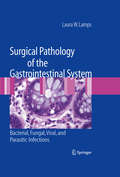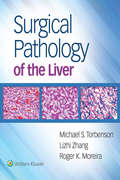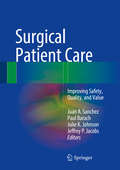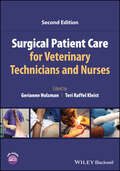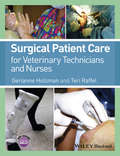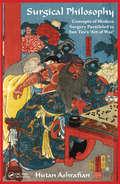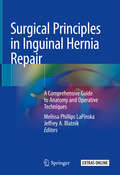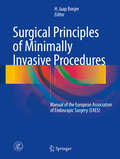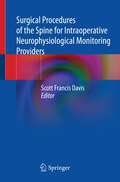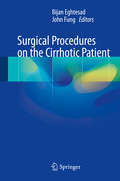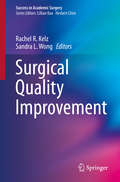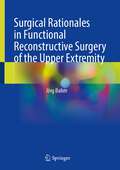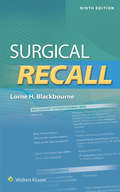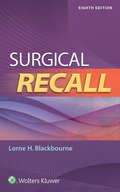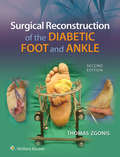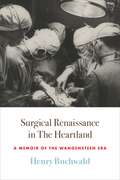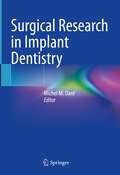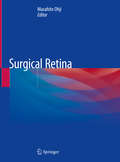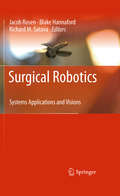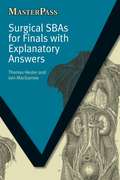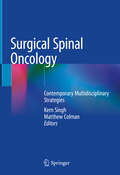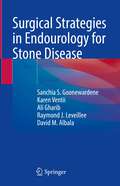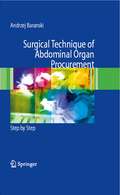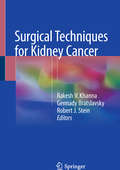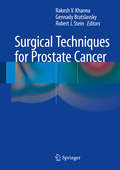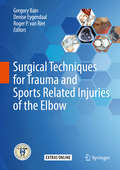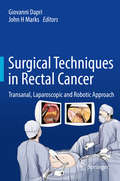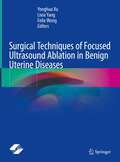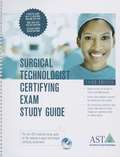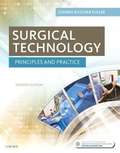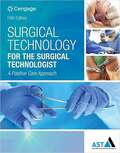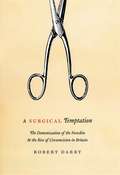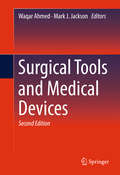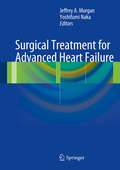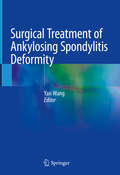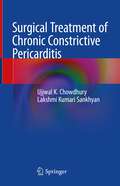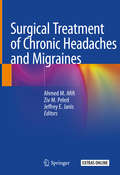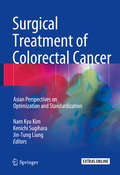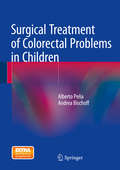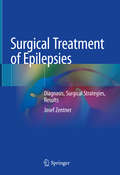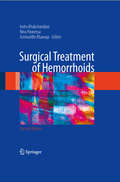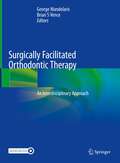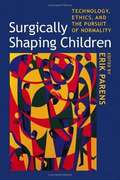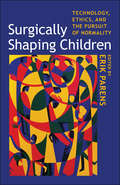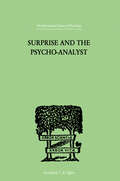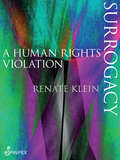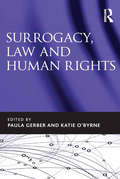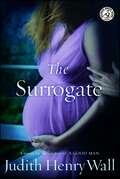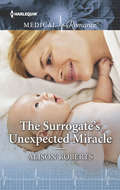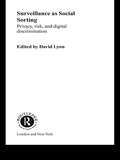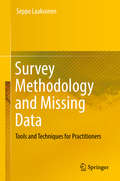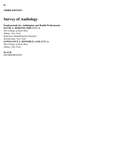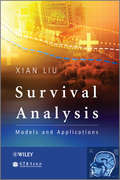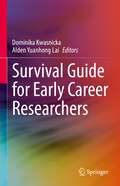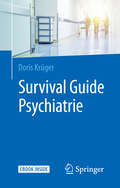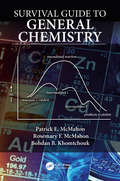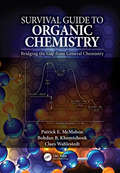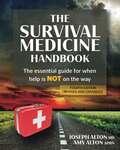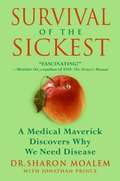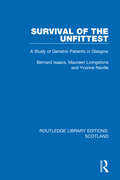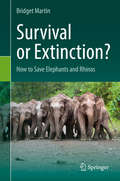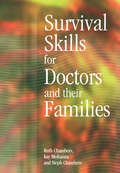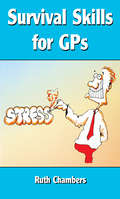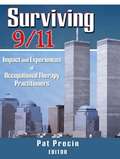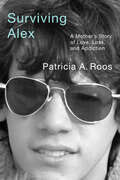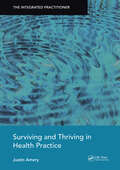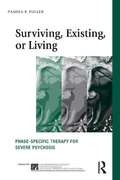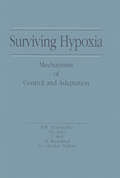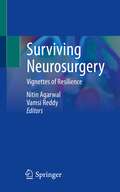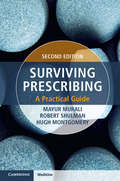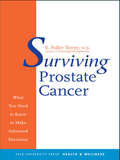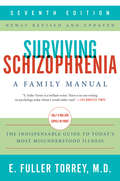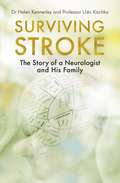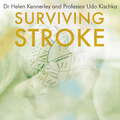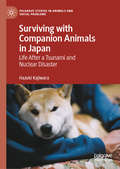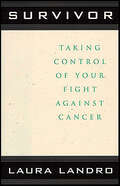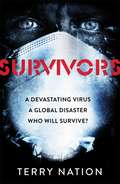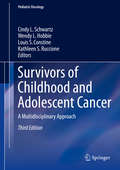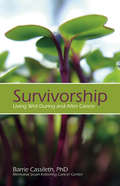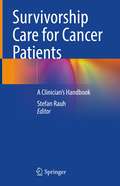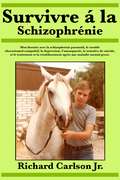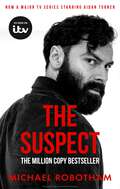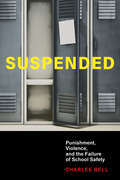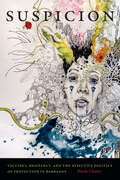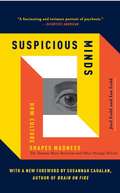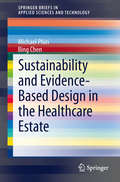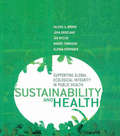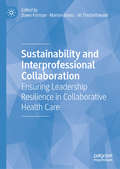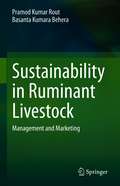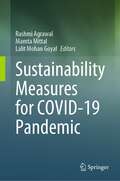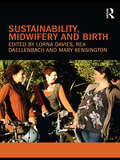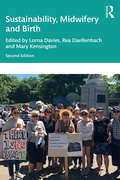- Table View
- List View
Surgical Pathology of the Gastrointestinal System: Bacterial, Fungal, Viral, and Parasitic Infections
by Laura W. LampsSurgical Pathology of the Gastrointestinal System: Bacterial, Fungal, Viral, and Parasitic Infections provides a unique diagnostic reference text for the pathologic diagnosis of infectious diseases of the gastrointestinal tract. Written for the practicing surgical pathologist, this text combines the superior illustrations of an atlas with carefully written prose to create a useful diagnostic companion. The text is divided into four sections covering bacterial, fungal, viral, and parasitic infections of the gastrointestinal tract. The descriptive sections of each chapter are organized into short paragraphs for easy reference and include the use of tables to compare and contrast organisms and summarize differential diagnoses. Each chapter is extensively illustrated, and contains prose discussions of diagnostic features, differential diagnoses, brief clinical descriptions, and ancillary tests that help confirm the diagnosis (i.e. immunohistochemistry, special histochemical stains, and molecular diagnostic techniques). Surgical Pathology of the Gastrointestinal System: Bacterial, Fungal, Viral, and Parasitic Infections provides pertinent clinical, diagnostic, and epidemiologic information that will be valuable to the practicing surgical pathologist. This volume will also help surgical pathologists gain familiarity with other contributory laboratory tests that are available to help confirm diagnosis.
Surgical Pathology of the Liver
by Michael Torbenson Roger Moreira Lizhi ZhangWritten by surgical pathologists for surgical pathologists, Surgical Pathology of the Liver focuses on sharpening your skills and knowledge in diagnostic histopathology, including laboratory and clinical findings that are directly useful when evaluating liver histology for clinical care. It offers comprehensive, superbly illustrated coverage of general liver pathology, as well as several chapters on topics that are not often included in liver pathology textbooks. Abundant high-quality illustrations have been carefully chosen to support and extend the information given in the text.
Surgical Patient Care
by Juan A. Sanchez Paul Barach Julie K. Johnson Jeffrey P. JacobsThis book focuses exclusively on the surgical patient and on the perioperative environment with its unique socio-technical and cultural issues. It covers preoperative, intraoperative, and postoperative processes and decision making and explores both sharp-end and latent factors contributing to harm and poor quality outcomes. It is intended to be a resource for all healthcare practitioners that interact with the surgical patient. This book provides a framework for understanding and addressing many of the organizational, technical, and cultural aspects of care to one of the most vulnerable patients in the system, the surgical patient. The first section presents foundational principles of safety science and related social science. The second exposes barriers to achieving optimal surgical outcomes and details the various errors and events that occur in the perioperative environment. The third section contains prescriptive and proactive tools and ways to eliminate errors and harm. The final section focuses on developing continuous quality improvement programs with an emphasis on safety and reliability. Surgical Patient Care: Improving Safety, Quality and Value targets an international audience which includes all hospital, ambulatory and clinic-based operating room personnel as well as healthcare administrators and managers, directors of risk management and patient safety, health services researchers, and individuals in higher education in the health professions. It is intended to provide both fundamental knowledge and practical information for those at the front line of patient care. The increasing interest in patient safety worldwide makes this a timely global topic. As such, the content is written for an international audience and contains materials from leading international authors who have implemented many successful programs.
Surgical Patient Care for Veterinary Technicians and Nurses
by Gerianne Holzman Teri Raffel KleistSurgical Patient Care for Veterinary Technicians and Nurses A step-by-step guide to caring for small animal surgical patients Surgical Patient Care for Veterinary Technicians and Nurses, Second Edition offers a complete, practical guide to nursing care for patients undergoing common and advanced surgeries in small animal practice. Written by veterinary technicians for veterinary technicians, the book is organized chronologically, beginning with the initial client contact and continuing through surgery to discharge and aftercare. The new edition significantly expands the surgical procedures chapter, adding new procedures, and incorporates updates to reflect new knowledge throughout. Topics cover all aspects of surgical patient care, including surgical assisting and patient comfort, for orthopedic, soft tissue, and emergency surgeries. A companion website offers video clips and review questions and answers, plus the figures from the book in PowerPoint. The Second Edition features: Hundreds of clinical photographs to support the text, with more than 100 images new to this edition, including many new instrument photos A logical chronological organization, from initial client communication through to discharge and aftercare instructions Topics ranging from laboratory testing, patient preparation, and instrument care and maintenance to bandaging, client communication, rehabilitation, encompassing orthopedic, ophthalmic, soft tissue, and emergency surgeries Expanded coverage of surgical procedures and wound management A companion website with video clips, review questions and answers, and the figures from the book in PowerPoint Surgical Patient Care for Veterinary Technicians and Nurses is equally useful for veterinary technician and nursing students and for veterinary technicians and nurses in practice, providing practical advice in a well-illustrated format.
Surgical Patient Care for Veterinary Technicians and Nurses
by Gerianne Holzman Teri RaffelSurgical Patient Care for Veterinary Technicians and Nurses is a highly practical reference covering all aspects of caring for canine and feline surgical patients. ? Covers all tasks associated with small animal surgical patient care, from the initial exam and beyond discharge ? Offers clear descriptions of common surgical assisting procedures and their etiology ? Presents 285 full-color clinical photographs to demonstrate common surgical instruments and assisting procedures and patient care ? Includes chapters on the history and physical examination, pre-operative planning, asepsis, surgical assisting, procedures, wound management, postoperative care, and aftercare ? Includes access to a companion website with review questions and answers and the figures from the book in PowerPoint
Surgical Philosophy: Concepts of Modern Surgery Paralleled to Sun Tzu's 'Art of War'
by Hutan AshrafianTreating disease can be considered a combat between curative therapies and pathological afflictions. As such, the action of achieving a cure can be likened to successfully waging war on sickness and bodily disorders. Surgical Philosophy applies the core principles derived from Sun Tzu's timeless book Art of War to combating disease through surgery.
Surgical Principles in Inguinal Hernia Repair: A Comprehensive Guide to Anatomy and Operative Techniques
by Melissa Phillips LaPinska Jeffrey A. BlatnikThis text is designed to present a comprehensive state-of-the-art approach to options available for inguinal hernia repair. Early chapters address anatomic evaluation of the groin, preoperative optimization of outcomes, and considerations in choosing a surgical technique. It then transitions to the clinical management of this common medical condition, specifically focusing on operative details. Written by experts in the field of hernia repair, the clinical chapters detail both open and minimally invasive techniques for repair including detailed anatomic drawings, surgical photos, and links to videos of operative techniques. Postoperative management is explained, detailing the common complications and addressing the importance of surgical outcomes, especially in the setting of “pay for performance” metrics. The final section of the text concludes with the management of inguinal hernias in select situations, including children, those performed with concomitant procedures, and modifications for training residents in this common surgical procedure. Each chapter includes a review of the published literature and selected references, along with anatomic illustrations, videos from operative interventions, and surgical photos to help reinforce the text.Surgical Principles in Inguinal Hernia Repair: A Comprehensive Guide to Anatomy and Operative Techniques will serve as a comprehensive resource for surgeons on patient preparation, surgical techniques, and outcomes for the management of inguinal hernias.
Surgical Principles of Minimally Invasive Procedures
by H. Jaap BonjerThe EAES Manual of Endoscopic Surgery provides surgeons and surgical residents with the best practical knowledge currently available on commonly performed minimally invasive abdominal and thoracic procedures. Expert European surgeons share their career-long experience by dissecting operative procedures step by step and highlighting potential technical and anatomical hazards. Authors instruct the reader in a fashion similar to the conversations that take place between master surgeons and their apprentices while scrubbing for surgery. Uniform full color illustrations complete the detailed descriptions of minimally invasive surgeries. In addition to the operative instructions, a key component of the manual is the provision of information on patient selection, choice of operative approach, special needs for minimally invasive procedures, and the early diagnosis and treatment of complications after surgery.
Surgical Procedures of the Spine for Intraoperative Neurophysiological Monitoring Providers
by Scott Francis DavisThis book equips the intraoperative monitoring provider (both technologist and physician) with details of commonly monitored surgical procedures of the spine. This knowledge better allows the monitorist to identify critical phases of the surgery and correlate those with neuroanatomical and functional risk at each phase. Chapters are authored by a surgeon and neurophysiologist, with the surgeon contributing procedural content and the neurophysiologist contributing information on how the monitoring integrates within the context of the procedure. It is the first book that incorporates content about the surgical procedure directly with the intraoperative monitoring plan for the surgery. This text will have a wide audience throughout the medical specialty of intraoperative neurophysiological monitoring; it will be of interest to technologists, interpreting physicians or neurophysiologists, anesthesiologists, and surgeons; essentially anyone on the surgical team that lacks a detailed knowledge of both the surgical procedure and the neurophysiology.
Surgical Procedures on the Cirrhotic Patient
by Bijan Eghtesad John FungThis volume provides a concise yet comprehensive overview on surgical procedures performed on the cirrhotic patient. The text explains the underlying pathophysiologic alterations in liver disease and cirrhosis, provides assessment of disease severity and risk factors, and helps to predict potential outcomes based on the nature of the operation. Operations discussed in detail include bariatric surgery, colorectal surgery, hepatic surgery, kidney transplantation, gynecological procedures, neurosurgical procedures, and ophthalmic surgery. The book is also supplemented with instructive color illustrations and tables. Written by experts in the field, Surgical Procedures on the Cirrhotic Patient is a valuable, multidisciplinary resource for clinicians who treat the cirrhotic patient. With a Foreword by Thomas E. Starzl, the father of liver transplantation.
Surgical Quality Improvement
by Rachel R. Kelz Sandra L. WongThis book teaches the theories and concepts behind surgical quality improvement and explains the skills and traits needed to become a high quality provider. The editors aim to teach and inspire the reader to achieve high quality outcomes and strive for continuous improvement.
Surgical Rationales in Functional Reconstructive Surgery of the Upper Extremity
by Jörg BahmThis book develops and describes surgical rationales in the field of reconstructive surgery for upper limb function, both in children and adults suffering from various diseases or trauma leading to a variety of motor and sensory impairments, sometimes associated with growth-related deformities. Every surgical career is a unique living story of learning, performing, questioning, trial and error, and finally success. Every surgeon has to integrate a wealth of information regarding ongoing clinical and research work in a range of disciplines; and with time and experience, a surgical rationale is developed that serves as a baseline and support for their day-to-day work.Following a structure starting with the patient’s needs, the surgeon and the training, the different tissues are addressed and their pathophysiology discussed in detail, including basic research and surgical expertise. The book is not a surgical compendium, but instead focuses on the detailed baseline behind day-to-day clinical examinations, functional evaluations and surgical work. Readers will learn how the tissues interact, how pathologies change them and interfere with their functions, and how to reverse the pathophysiological sequence by surgical-technical means to improve function.Although the book presents the author’s personal views, all aspects are explained and debated on the basis of past and current clinical findings, ongoing basic research and input from other disciplines: readers may disagree with certain points, but choose to implement some of the rationales and priorities, incorporate findings from fields they’d never previously explored, or investigate them further.This book offers an extensive framework of argumentation and is intended to inspire and support readers in terms of decision-making and understanding current or uncommon procedures. Practitioners in the fields of peripheral nerve surgery, reconstructive plastic surgery, upper limb orthopedics, neuropediactrics, biomechanics, physiotherapy and ergotherapy will find the book a valuable asset, and a trusted companion in the daily quest to improve patient care!
Surgical Recal (Recall Series)
by Lorne BlackbourneBuild the Confidence for Success on Your Exams and in the Operating Suite! Written in a rapid-fire question-and-answer format ideal for learning on the go, this best-selling clerkship resource covers both general surgery and surgical subspecialties and provides accurate, on-the-spot answers to the questions most likely encountered during rotations and on the shelf exam. This enhanced ninth edition reflects the latest advances in key areas, as well as additional Rapid-Fire Review questions and new Rapid-Fire Vignettes to prepare students for success on exams and beyond.
Surgical Recall (Recall Ser.)
by Lorne BlackbourneWritten in a rapid-fire question-and-answer format, Surgical Recall is a best-selling, high-yield reference for clerkship students.
Surgical Reconstruction of the Diabetic Foot and Ankle
by Thomas ZgonisEmphasizing a multidisciplinary team approach, Surgical Reconstruction of the Diabetic Foot and Ankle, 2nd Edition, is an easy-to-follow, well-illustrated guide to the latest surgical techniques in diabetic lower extremity reconstruction. Dr. Thomas Zgonis and an expert team of national and international authors share their extensive knowledge and experience in the surgical treatment of diabetic patients, including challenging clinical scenarios of severe infections, lower extremity deformities, peripheral arterial disease, and soft tissue compromise.
Surgical Renaissance in the Heartland: A Memoir of the Wangensteen Era
by Henry BuchwaldIn 1960, fresh out of a stint in the Air Force, Henry Buchwald was recruited by Dr. Owen H. Wangensteen to join the Department of Surgery at the University of Minnesota&’s medical school. For an American born in Austria, a child of the Holocaust, a position in a city then considered by some to be the &“anti-Semitic capital of the United States&” might seem an uneasy fit, but in the culture of innovation created by Wangensteen, Buchwald, who had chafed against the rigidity of East Coast medical practice, found everything an imaginative young surgeon could have asked for. Surgical Renaissance in the Heartland is the story of a golden era in American surgery, ushered in by Wangensteen&’s creative approach to medical practice, told by one who lived it.Buchwald describes the roots, heritage, and traditions of this remarkable period at the University of Minnesota&’s medical school, where the foundations of open-heart procedures, heart and pancreas transplantation, bariatric surgery, implantable infusion pump therapies, and other medical landmarks originated. Buchwald&’s account of the Wangensteen era brings to life a medical culture that thrived on debate and the expression of ideas, a clinical practice bound only by the limits of a surgeon&’s inspiration and imagination. As entertaining as it is informative, Surgical Renaissance in the Heartland effectively conjures the character—and characters—of a time that forever changed medicine and the lives of millions.
Surgical Research in Implant Dentistry
by Michel M. DardThis book explores, in a comprehensive and systematic manner, Surgical Research methodologies to the design and development of investigational studies in the field of implant-based oral rehabilitation. Such studies are linked in a chain binding in vitro, in vivo, ex vivo, and digital evaluations. An ambitious objective consists in exposing how investigators can generate and deliver knowledge by capturing synergy coming from preclinical and clinical trials. Accordingly, throughout the book, translational aspects are closely scrutinized. The opening chapters consider materials, methods and procedures for preclinical and clinical studies in which approaches and models are extensively described. The focus then moves to the process by which application of histology, biomechanics, biomarkers, cellular/molecular biology, and imaging technologies lead to new results and consequently novel treatment concepts in implant dentistry, implant borne prosthetic rehabilitations and the replacement or regeneration of tissues. Finally, the exciting opportunities afforded by the digital world are addressed. This book shall be a valuable resource and time-saving tool for a wide audience of researchers, students, practitioners, and academics.
Surgical Retina (Retina Atlas)
by Masahito OhjiThis atlas presents the state-of-the-art in vitreoretinal surgery. In ten chapters written by internationally respected vitreoretinal surgeons, it addresses various surgical diseases of the retina and vitreous, providing detailed information on all key surgical aspects. The topics covered include small-gauge vitrectomy and surgical aspects of retinal detachment, proliferative vitreoretinopathy, proliferative diabetic retinopathy, serous macular detachment with optic disc pit, coloboma of the choroid, and cysticercosis. Surgical aspects of various macular diseases such as epiretinal membrane, vitreomacular traction syndrome, and macular hole are also examined. Given its scope, the book offers a valuable asset for practicing ophthalmologists, vitreoretinal specialists, and trainees in the field. The Surgical Retina Atlas is one of nine volumes in the series Retina Atlas, which provides comprehensive and validated information on vitreoretinal diseases, covering imaging basics, retinal vascular disease, macular disorders, ocular inflammatory and infectious disorders, retinal degeneration, surgical retina, ocular oncology, pediatric retina and trauma.
Surgical Robotics
by Blake Hannaford Richard M. Satava Jacob RosenSurgical robotics is a rapidly evolving field. With roots in academic research, surgical robotic systems are now clinically used across a wide spectrum of surgical procedures. Surgical Robotics: Systems Applications and Visions provides a comprehensive view of the field both from the research and clinical perspectives. This volume takes a look at surgical robotics from four different perspectives, addressing vision, systems, engineering development and clinical applications of these technologies. The book also: -Discusses specific surgical applications of robotics that have already been deployed in operating rooms -Covers specific engineering breakthroughs that have occurred in surgical robotics -Details surgical robotic applications in specific disciplines of surgery including orthopedics, urology, cardiac surgery, neurosurgery, ophthalmology, pediatric surgery and general surgery Surgical Robotics: Systems Applications and Visions is an ideal volume for researchers and engineers working in biomedical engineering.
Surgical SBAs for Finals with Explanatory Answers (MasterPass)
by Thomas Hester Iain MacGarrowSingle best answer (SBA) questions are increasingly popular in medical examinations, and can be challenging: more than one answer may at first appear correct, creating pitfalls for the unwary. This book has been written for medical students throughout their clinical years, including a mixture of clinical and basic science questions that cover the essential topics of surgery. The questions test and reaffirm knowledge through clinical scenarios, making the subject matter engaging, enjoyable and memorable. Explanatory answers both aid learning and help candidates identify areas where further revision is needed.
Surgical Spinal Oncology: Contemporary Multidisciplinary Strategies
by Kern Singh Matthew ColmanThis book contains the expert knowledge base of the field’s most experienced practitioners in the field of extradural bone and soft tissue malignancy. Chapters include modern classification, advanced anatomy, imaging, and the concepts around a multidisciplinary approach. Since treating primary tumors requires very different strategies than those used in metastatic tumors, the book devotes separate sections to each sub-discipline. For primary tumors, the text covers both benign and malignant entities and addresses unique anatomic zones such as the sacrum and skull base which require special technical expertise. For metastatic disease, the authors address the ever-important concept of prognosis, and discuss how to answer the eternal question: “How much should we do, and for whom?”. Chapters also explore the state of the art of treatment for the “big 5” histologies (renal cell, lung, breast, prostate, thyroid), with a special chapter emphasis on separation surgery and the now-standard combinatorial care between radiation and surgery. In addition, an entire section is dedicated to evolving surgical technology, which covers the use of minimally invasive techniques, navigation, robotics, 3D-printing, and other evolving technologies for spine tumor care. Infrequently-considered topics, such as how to evaluate a lesion which may be a tumor-mimic, and how to think about economic value in spine tumor surgery, are also presented.Surgical Spinal Oncology serves to help surgeons approach difficult clinical scenarios with a thoughtful, collaborative approach that leverages the best technology and thinking the field of spine oncology has to offer.
Surgical Strategies in Endourology for Stone Disease
by Sanchia S. Goonewardene Karen Ventii Ali Gharib Raymond J. Leveillee David M. AlbalaThis book provides a practical guide to surgical endourology. Evidence-based chapters give expert opinion on complex cases, best practice techniques, and treating complications. The book covers a broad range of topics required within urological treatment including basic science, imaging in endourology, the use of technological devices, therapeutics for endourology, the treatment of high risk patients, stone disease management, pelvic kidneys, and dialysis. Surgical Strategies in Endourology aims to give the reader guidance in treating patients with endourological conditions and is relevant to both practising and trainee urologists.
Surgical Technique of the Abdominal Organ Procurement
by Andrzej BaranskiThe book encompasses Dr Baranski's 20 year experience in the field of abdominal organ donation. It is a step-by-step guide with photographs and drawings with clear explanations highlighting pitfalls. The book quickly and easily guides the reader through the difficult steps during organ procurement. It is mainly illustration-based, without much text, and covers surgical technical mistakes and organ damage.
Surgical Techniques for Kidney Cancer
by Rakesh V. Khanna Gennady Bratslavsky Robert J. SteinSurgical Techniques for Kidney Cancer provides a comprehensive review and detailed description of surgical techniques for kidney and adrenal cancer. Through a step by step approach various surgical techniques are covered including radical nephrectomy, partial nephrectomy, and thermal ablation for renal cortical tumors. Each step by step approach is followed by the latest data on outcomes. Furthermore, limitations as well as tips and tricks are detailed in addition to management of common complications. Kidney Surgery for Urologists will be a valuable resource for Urologists, Urological Surgeons, Fellows in Urologic Oncology and Minimally Invasive/Robotic Surgery as well as upper level residents training in Urology.
Surgical Techniques for Prostate Cancer
by Rakesh V. Khanna Gennady Bratslavsky Robert J. SteinThis volume provides a comprehensive review and detailed description of surgical techniques for prostate cancer surgery. All aspects are covered, including surgical anatomy and methods of transrectal ultrasound guided prostate biopsies, step-by-step approach techniques for radical prostatectomy, and the latest data on outcomes. Furthermore, limitations as well as tips and tricks are detailed in addition to management of common complications. Lastly, with the increasing use of ablative therapy and brachytherapy, the mechanism of action as well as the keys to obtaining optimal outcomes are illustrated. Surgical Techniques for Prostate Cancer is a concise and valuable resource to surgeons that documents the different approaches to prostate cancer surgery.
Surgical Techniques for Trauma and Sports Related Injuries of the Elbow
by Gregory Bain Denise Eygendaal Roger P. van RietIn this book, leading international surgeons with expertise in the field provide cutting-edge information on the surgical techniques to treat sports and trauma injuries of the elbow. Indications for the different techniques are clearly explained, and practical aspects that allow safe and reproducible clinical outcomes are described. For the common procedures, a number of surgical technique options are presented, ensuring that the reader gains a broader perspective on this evolving surgical field. Throughout, valuable tips and tricks are highlighted that will assist both the experienced and the training surgeon in achieving maximum efficiency in their surgical practice. The book includes hundreds of illustrations, line diagrams, and clinical and cadaveric photographs to assist the reader in appreciating the principles of the clinical anatomy and the surgical techniques. Videos aid in understanding the finer points of the procedures. Surgical Techniques for Sports and Trauma Related Injuries of the Elbow is published in collaboration with ISAKOS. It will provide readers with a new comprehension of the topic and will be of value to students, physiotherapists, sports physicians, and orthopaedic surgeons.
Surgical Techniques in Rectal Cancer
by Giovanni Dapri John H MarksThis book describes the various procedures, including surgery through the abdominal wall, through a transanal access or by the union of both, using an open, laparoscopic, or robotic approach. Worldwide pioneers for each technique are invited as authors and portray in step-by-step detail about each procedure. Of the 32 chapters, 23 are dedicated only for the surgical procedures. Each chapter is enriched by numerous figures, which complement the text, permitting the understanding of each surgical technique from its beginning until the last step. Eight additional chapters are dedicated to the clinical and anatomical aspects of rectal cancer.In the last decade there has been an impressive evolution in the treatment of patients with rectal cancer, with a focus not only on the preservation of a cancer-free life, but the quality of that life. This book has been written to be useful for everyone involved in rectal cancer management. From internists, gastroenterologists, endoscopists, oncologists, radiotherapists and radiologists involved in the treatment of rectal cancer during their daily practice, to surgeons specialized in colorectal surgery, to junior faculty to trainees, all interested in new and innovative techniques.
Surgical Techniques of Focused Ultrasound Ablation in Benign Uterine Diseases
by Yonghua Xu Lixia Yang Felix WongThis book aims to provide readers advanced information on the clinical application of MRI and ultrasound-guided focused ultrasound ablation for benign uterine diseases. Followed by a brief introduction of the principle and method of focused ultrasound ablation, and imaging diagnosis of uterine fibroids and adenomyosis, typical cases of focused ultrasound ablation treatment for uterine fibroids, adenomyosis and other benign uterine diseases are presented, accompanying with high-resolution illustrations. Key points in imaging diagnosis, efficacy prediction, ablation procedure, and posttreatment evaluation are included. The possible complications and treatment strategies are also discussed. It will be a useful reference for gynaecologists and practitioners to perform focused ultrasound ablation for the treatment of benign uterine diseases.
Surgical Technologist Certifying Exam Study Guide
by AsaThe only AST-endorsed study guide for the NBSTSA national surgical technologist certifying examination that provides 6 practice exams and bonus basic science review questions for a total of 1,386 practice questions. Each exam reflects the NBSTSA exam content outline. An explanation of each answer is provided and the references are available on the AST web site, www.ast.org under the "Students" tab. The front matter provides techniques in preparing for the exam including studying technical material and retention techniques. Preparing for the exam can be a challenging task that started on the first day of your program and this study guide serves as a study tool to reinforce the learning that took place while attending the program. Good luck!!!
Surgical Technology: Principles and Practice
by Joanna FullerLearn to deliver the best patient care before, during, and after surgery with Surgical Technology: Principles and Practice, 7th Edition. Within its pages you ll find comprehensive coverage of all the updated AST Core Curriculum components including all aspects of health care sciences; technological sciences; patient care concepts; preoperative, intraoperative, and postoperative care; surgical procedures; and professional practice. But what you won t find in any other surg tech book is an incredibly reader-friendly approach featuring conversational, mentor-like guidance and loads of full-color pictures and illustrations. You ll also have an abundance of helpful learning features at your disposal like case studies, review questions, and online learning activities that will help you easily master important concepts and apply that learning to professional practice. No other surgical technology text better prepares you for the challenges of professional practice!
Surgical Technology for the Surgical Technologist: A Positive Care Approach
by Kevin B. Frey Association of Surgical Technologists Inc.Packed with detailed, full-color illustrations and live surgery images, market-leading SURGICAL TECHNOLOGY FOR THE SURGICAL TECHNOLOGIST: A POSITIVE CARE APPROACH, 5e, delivers the most up-to-date and comprehensive coverage of over 200 essential surgical procedures. <p><p>It also includes essential topics such as equipment and supplies, operative preparation, practical and technical considerations, and postoperative considerations. "Pearls of Wisdom" features offer practical insight from surgical technologists in the field, and numerous learning resources help you maximize your course success -- including "A POSITIVE CARE" memory tool, real-life case studies with critical thinking questions, and the powerful digital learning solution MindTap. <p><p>Preparing you for real-world practice, SURGICAL TECHNOLOGY FOR THE SURGICAL TECHNOLOGIST, 5e, is the ultimate resource for helping you anticipate the patient's and surgeon's needs before, during, and after a surgical procedure.
A Surgical Temptation: The Demonization of the Foreskin and the Rise of Circumcision in Britain
by Robert DarbyIn the eighteenth century, the Western world viewed circumcision as an embarrassing disfigurement peculiar to Jews. A century later, British doctors urged parents to circumcise their sons as a routine precaution against every imaginable sexual dysfunction, from syphilis and phimosis to masturbation and bed-wetting. Thirty years later the procedure again came under hostile scrutiny, culminating in its disappearance during the 1960s. Why Britain adopted a practice it had traditionally abhorred and then abandoned it after only two generations is the subject of A Surgical Temptation. Robert Darby reveals that circumcision has always been related to the question of how to control male sexuality. This study explores the process by which the male genitals, and the foreskin especially, were pathologized, while offering glimpses into the lives of such figures as James Boswell, John Maynard Keynes, and W. H. Auden. Examining the development of knowledge about genital anatomy, concepts of health, sexual morality, the rise of the medical profession, and the nature of disease, Darby shows how these factors transformed attitudes toward the male body and its management and played a vital role in the emergence of modern medicine.
Surgical Tools and Medical Devices
by Waqar Ahmed Mark J. JacksonThis new edition presents information and knowledge on the field of biomedical devices and surgical tools. The authors look at the interactions between nanotechnology, nanomaterials, design, modeling, and tools for surgical and dental applications, as well as how nanostructured surfaces can be created for the purposes of improving cell adhesion between medical devices and the human body. Each original chapter is revised in this second edition and describes developments in coatings for heart valves, stents, hip and knee joints, cardiovascular devices, orthodontic applications, and regenerative materials such as bone substitutes. There are also 8 new chapters that address: Microvascular anastomoses Inhaler devices used for pulmonary delivery of medical aerosols Surface modification of interference screws Biomechanics of the mandible (a detailed case study) Safety and medical devices The synthesis of nanostructured material Delivery of anticancer molecules using carbon nanotubes Nano and micro coatings for medical devices This book is appropriate for engineers, material scientists, chemists, physicists, biologists, medical and dental professionals with an interest in biomedical devices and tools, and researchers in the same fields.
Surgical Treatment for Advanced Heart Failure
by Jeffrey A. Morgan Yoshifumi NakaThe treatment of end-stage heart failure with advanced surgical therapies has evolved significantly over the last several years and is a dynamic subspecialty within cardiac surgery. Surgical Treatment for Advanced Heart Failure describes the surgical management of advanced heart failure, including coronary artery revascularization, mitral valve repair, aortic valve replacement, ventricular remodeling, cardiac resynchronization, mechanical circulatory support with short-term devices for acute stabilization, long-term mechanical support as a bridge to transplant and for destination therapy, left ventricular assist devices, complete cardiac replacement with the total artificial heart, and cardiac transplantation. With contributions from a distinguished group of heart failure cardiologists and transplant surgeons, it is an authoritative resource for cardiac surgeons, cardiologists, and surgeons.
Surgical Treatment of Ankylosing Spondylitis Deformity
by Yan WangThis book introduces surgical treatment of ankylosing spondylitis in details, aiming to help surgeons to make better planning and technique. In part 1, authors mainly introduce the osteotomy technique in AS and surgery planning. Moreover, the benefits in organ function brought by spinal correction are introduced in the same chapter. The hips are the most commonly effected diarthrodial joint in patients with AS, and the stiff hip causes poor life quality. In part 2, authors mainly introduce the skills of total hip arthroplasty (THA) in AS. For some patients both with kyphosis and hip involvement, how the authors make surgery planning. ln part 3, authors introduce their experiences and methods, including the advantages and disadvantages when do spinal correction first or THA first, and the principle of making spinal correction match with THA well.
Surgical Treatment of Chronic Constrictive Pericarditis
by Ujjwal K. Chowdhury Lakshmi Kumari SankhyanThis book provides comprehensive information and clarity on all aspects of diagnosing and managing constrictive pericarditis. The operative procedures for constrictive pericarditis are presented in detail with technical tips supplemented by surgical videos. Further, it explores and guides on issues with mixed opinions like the role of corticosteroids, timing of the operation, choice of the operative procedure, terminologies to describe the extent of decortication, and the requirement of cardiopulmonary bypass. Despite experience spanning over 100 years, there is no fool-proof formula in the published literature that can be used in selecting an optimal surgical approach for a given patient. The terms "radical", "total", "extensive", "complete", "subtotal", "adequate", "near-total" and "partial" pericardiectomy also have been variably used in the literature, often without a precise definition of the limits of pericardial resection.Providing an update on the latest advancements and long-term results of pericardiectomy appeals to all clinicians managing constrictive pericarditis. For the trainees, it offers insights into surgical techniques' relevant anatomy and foundation. The book will be beneficial to MBBS, MD, MS, M.Ch (CTVS), DM (Cardiology), Diplomate of National Board (Cardiology and CTVS), FRCS, FRACS, MD (USA, Canada, and in all developing and developed countries).
Surgical Treatment of Chronic Headaches and Migraines
by Ahmed M. Afifi Ziv M. Peled Jeffrey E. JanisSince its serendipitous discovery, surgeons and physicians have continued to study and refine the surgical treatment of chronic headaches. This innovation has been a “disruptive” treatment challenging the classical methods of management for patients living with migraines. This comprehensive reference provides the starting point for many surgeons who are entering this field and also describes intricate and variable technical details, providing the reader with a basic knowledge while delving deeper into techniques honed through years of treatment experience. Surgical Treatment of Chronic Headaches and Migraines is organized across 17 chapters and contributed to by a multidisciplinary wealth of practitioners in the fields of plastic surgery, neurology, pain medicine, and more. Topics examine the various types of headaches that may require surgical treatment and include postoperative care alongside minimally invasive interventions. The text is rounded out by a look towards the future in this field and further enhanced by high-quality videos, tables, and figures, making it a valuable reference for anyone looking to treat patients exhibiting the debilitating pain of chronic headaches and migraines.
Surgical Treatment of Colorectal Cancer: Asian Perspectives On Optimization And Standardization
by Nam Kyu Kim Kenichi Sugihara Jin-Tung LiangThis book presents an Asian perspective on how the treatment of colorectal cancer can be optimized and standardized in ways that take into account technological advances and the trend towards individually tailored therapy. Readers will find careful, well-illustrated descriptions of the standard surgical techniques for rectal cancer and colon cancer that have contributed to recent improvements in 5-year survival rates in the Asia-Pacific region, where the incidence of colorectal cancer has been rising alarmingly due to lifestyle changes. The vital role now being played by minimally invasive laparoscopic and robotic options receives detailed scrutiny. Extent and timing of surgery, patient safety, risk of complications, and unresolved issues are all discussed. Furthermore, the use of surgery within the context of multimodal management including chemotherapy and radiotherapy is explained and an integrated approach for stage IV and recurrent disease is described. The book will serve as a valuable reference for young surgeons who are in training, experienced practitioners who want to enhance their knowledge and skills, and all others who wish to learn about this field.
Surgical Treatment of Colorectal Problems in Children
by Alberto Peña Andrea BischoffThis superbly illustrated book on the surgical treatment of pediatric colorectal problems focuses in particular on the specific technical maneuvers that may be considered key to successful results. The presented management concepts are based on a database comprising over 5000 patients, more than 2300 of whom have been operated on by one of the authors as lead surgeon over the past 30 years. The full range of colorectal disorders in children is thus covered, from cloaca and fistulas to rare presentations. In addition, chapters are included on topics such as prenatal diagnosis, minimally invasive techniques, recent advances in imaging, and a bowel management program for fecal incontinence. Surgical Treatment of Colorectal Problems in Children is eminently a practical book. Clarity, simplicity and applicability are emphasized throughout. The excellence of the illustrations and photographs is a crucial feature and the reader will also have access to instructive videos of procedures.
Surgical Treatment of Epilepsies: Diagnosis, Surgical Strategies, Results
by Josef ZentnerThis book fills the gap between the increasing demand for epilepsy surgical experience and limited training facilities in this area. It comprehensively describes surgical techniques, including tricks and pitfalls, based on the author’s 30 years of experience, providing optimal and effective training for young neurosurgeons by avoiding learning by trial and error. Moreover, it also includes useful information for epileptologists and other professionals involved in the epilepsy surgical program to allow them to gain a better understanding of possibilities and limitations of epilepsy surgery.
Surgical Treatment of Hemorrhoids
by Indru Khubchandani Nina Paonessa Khawaja AzimuddinThe second edition of Surgical Treatment of Hemorrhoids covers this important and common disorder, offering a comprehensive critical analysis of advantages and disadvantages of recognized treatment options, covering both recent advances and traditional treatments in the field. The topics covered include essential elements of diagnosis, surgical technique and after-care for the main operations used in hemorrhoid surgery. Providing authoritative in-depth presentations of all perspectives and latest techniques available, the individual procedures are each described by an internationally recognized expert, and the full range of treatment options is covered. The chapters have been revised, with some additions and updates, including stapled hemorrhoidectomy and office management, and also hemorrhoidectomy with several concomitant comorbidities. This uniquely comprehensive guide is essential reading for all practicing and trainee colorectal and general surgeons.
Surgically Facilitated Orthodontic Therapy: An Interdisciplinary Approach
by George A. Mandelaris Brian S. VenceThis book covers all aspects of Surgically Facilitated Orthodontic Therapy and is intended to guide practitioners involved in dental interdisciplinary therapy to managing complex cases. It demonstrates the next level of collaboration through managing core problems of the patients and planning cases using digital dentistry for enhanced disclosed and more ideal outcomes. Methods for regaining space appropriation and dentoalveolar bone engineering are illustrated. Emphasis is placed on corticotomy assisted orthodontic therapy and 3D planning in order to help practitioner to achieve outcomes that were previously unrecognized. The book is written by leading experts in the field and is a rich source for periodontists, oral and maxillofacial surgeons, orthodontists and restorative clinicians interested in the subject.
Surgically Shaping Children: Technology, Ethics, and the Pursuit of Normality
by Erik ParensAt a time when medical technologies make it ever easier to enhance our minds and bodies, a debate has arisen about whether such efforts promote a process of "normalization," which makes it ever harder to tolerate the natural anatomical differences among us. The debate becomes especially complicated when it addresses the surgical alteration, or "shaping," of children. This volume explores the ethical and social issues raised by the recent proliferation of surgeries designed to make children born with physical differences look more normal. Using three cases—surgeries to eliminate craniofacial abnormalities such as cleft lip and palate, surgeries to correct ambiguous genitalia, and surgeries to lengthen the limbs of children born with dwarfism—the contributors consider the tensions parents experience when making such life-altering decisions on behalf of or with their children. The essays in this volume offer in-depth examinations of the significance and limits of surgical alteration through personal narratives, theoretical reflections, and concrete suggestions about how to improve the decision-making process. Written from the perspectives of affected children and their parents, health care providers, and leading scholars in philosophy, sociology, history, law, and medicine, this collection provides an integrated and comprehensive foundation from which to consider a complex and controversial issue. It takes the reader on a journey from reflections on the particulars of current medical practices to reflections on one of the deepest and most complex of human desires: the desire for normality.
Surgically Shaping Children: Technology, Ethics, and the Pursuit of Normality
by Erik ParsensWinner of an Honorable Mention in the Clinical Medicine category of the Professional and Scholarly Publishing Awards given by the Association of American PublishersAt a time when medical technologies make it ever easier to enhance our minds and bodies, a debate has arisen about whether such efforts promote a process of "normalization," which makes it ever harder to tolerate the natural anatomical differences among us. The debate becomes especially complicated when it addresses the surgical alteration, or "shaping," of children. This volume explores the ethical and social issues raised by the recent proliferation of surgeries designed to make children born with physical differences look more normal.Using three cases—surgeries to eliminate craniofacial abnormalities such as cleft lip and palate, surgeries to correct ambiguous genitalia, and surgeries to lengthen the limbs of children born with dwarfism—the contributors consider the tensions parents experience when making such life-altering decisions on behalf of or with their children.The essays in this volume offer in-depth examinations of the significance and limits of surgical alteration through personal narratives, theoretical reflections, and concrete suggestions about how to improve the decision-making process. Written from the perspectives of affected children and their parents, health care providers, and leading scholars in philosophy, sociology, history, law, and medicine, this collection provides an integrated and comprehensive foundation from which to consider a complex and controversial issue. It takes the reader on a journey from reflections on the particulars of current medical practices to reflections on one of the deepest and most complex of human desires: the desire for normality.ContributorsPriscilla Alderson, Adrienne Asch, Cassandra Aspinall, Alice Domurat Dreger, James C. Edwards, Todd C. Edwards, Ellen K. Feder, Arthur W. Frank, Lisa Abelow Hedley, Eva Fedder Kittay, Hilde Lindemann, Jeffery L. Marsh, Paul Steven Miller, Sherri G. Morris, Wendy E. Mouradian, Donald L. Patrick, Nichola Rumsey, Emily Sullivan Sanford, Tari D. Topolski
Surprise And The Psycho-Analyst: On the Conjecture and Comprehension of Unconscious Processes
by Reik, TheodorFirst published in 1999. Routledge is an imprint of Taylor & Francis, an informa company.
Surprise Baby for the Billionaire: Best Friend To Royal Bride / Surprise Baby For The Billionaire (Harlequin Lp Medical Ser.)
by Charlotte HawkesFrom passion, to pregnancy… to a family for real?Betrayed by her cheating fiancé, pediatrician Saskia fell into the arms of brooding entrepreneur Malachi Gunn. Her on-the-rebound encounter has consequences she never could have imagined—she’s pregnant! Whisking her away to his Tuscan villa, Malachi makes it clear she must wed him to give their baby the family it deserves. But can Saskia settle for a paper marriage…or should she hope for more?From Harlequin Medical Romance: Life and love in the world of modern medicine.
Surrogacy: A Human Rights Violation
by Renate KleinSurrogacy is heavily promoted by the stagnating IVF industry which seeks new markets for women over 40, and gay men who believe they have a ‘right' to their own children and ‘family foundation'. Pro-surrogacy groups in rich countries such as Australia and Western Europe lobby for the shift to commercial surrogacy. Their capitalist neo-liberal argument is that a well-regulated fertility industry would avoid the exploitative practices of poor countries. Central to the project of transnational surrogacy is the ideology that legalized commercial surrogacy is a legitimate means to provide infertile couples and gay men with children who share all or part of their genes. Women, without whose bodies this project is not possible are reduced to incubators, to ovens, to suitcases. And the ‘product child' is a tradable commodity who has never consented to being a ‘take away baby': removed from their birth mother and given to strangers aka ‘intended parents'. Still, those in favour of this practice of reproductive slavery speak of ‘Fair Trade International Surrogacy' and ‘responsible surrogacy'.
Surrogacy, Law and Human Rights
by Paula Gerber Katie O'ByrneSurrogacy presents particularly complex questions for human rights law and theory. This book provides a unique and insightful examination into the underexplored issues of how domestic and international law is responding to the sharp increase in the use of surrogacy. The work presents critical analysis of the current regulation of surrogacy via domestic law in Australia, India and the USA, and international law in the form of the UN Convention on the Rights of the Child. Including a wide range of views from academics and practitioners around the world, the contributors consider what could be done to further protect the rights of all persons involved in surrogacy arrangements. This in-depth study of the international and domestic law governing surrogacy provides much needed scholarly knowledge of this contemporary phenomenon, along with recommendations for improvement, regulation and reform. The book will be of great importance to human rights and legal scholars, and well as practitioners in this field.
The Surrogate: A Novel
by Judith Henry WallTo a penniless twenty-year-old like Jamie Long, surrogate motherhood seemed both an act of altruism and a financial opportunity. But once pregnant and under contract to Amanda Hartmann, the head of a famous evangelical family, Jamie realizes that she's getting more than she bargained for. Whisked away to the vast, isolated family ranch, she's closely supervised and carefully cut off from the outside world. She learns the family's dark secrets -- and sees the enormity of their ruthlessness. When Jamie hears Amanda's plan to claim the baby as her natural-born child, she begins to suspect that her own life is in danger and resolves to flee. Alone with a tiny newborn, she calls on the one man in the world she can trust -- her high school crush, Joe Brammer. Their love unites them in a struggle to escape, and soon enough their flight becomes a fight for their lives. Brilliantly weaving some of today's most controversial social issues into a captivating page-turner,The Surrogateis Judith Henry Wall's greatest triumph to date.
The Surrogate's Unexpected Miracle
by Alison RobertsTheir unexpected family Ellie Thomas was meant to be a surrogate mother to the baby growing inside her, but when her best friend abandons her, everything changes. The moment her son is born, Ellie knows she could never give him up! But the one person she can turn to for help is the doctor who delivered her child. Dr. Luke Gilmore didn't have a picture-perfect childhood, but he instinctively wants to protect Ellie and her baby. He was only passing through, but he may have just found a reason to stay...
Surveillance as Social Sorting: Privacy, Risk and Automated Discrimination
by David LyonSurveillance happens to all of us, everyday, as we walk beneath street cameras, swipe cards, surf the net. Agencies are using increasingly sophisticated computer systems - especially searchable databases - to keep tabs on us at home, work and play. Once the word surveillance was reserved for police activities and intelligence gathering, now it is an unavoidable feature of everyday life.Surveillance as Social Sorting proposes that surveillance is not simply a contemporary threat to individual freedom, but that, more insidiously, it is a powerful means of creating and reinforcing long-term social differences. As practiced today, it is actually a form of social sorting - a means of verifying identities but also of assessing risks and assigning worth. Questions of how categories are constructed therefore become significant ethical and political questions.Bringing together contributions from North America and Europe, Surveillance as Social Sorting offers an innovative approach to the interaction between societies and their technologies. It looks at a number of examples in depth and will be an appropriate source of reference for a wide variety of courses.
Survey Methodology and Missing Data: Tools and Techniques for Practitioners
by Seppo LaaksonenThis book focuses on quantitative survey methodology, data collection and cleaning methods. Providing starting tools for using and analyzing a file once a survey has been conducted, it addresses fields as diverse as advanced weighting, editing, and imputation, which are not well-covered in corresponding survey books. Moreover, it presents numerous empirical examples from the author's extensive research experience, particularly real data sets from multinational surveys.
Survey of Audiology: Fundamentals for Audiologists and Health Professionals
by David A. DeBonis Constance L. DonohueIn Survey of Audiology: Fundamentals for Audiologists and Health Professionals, Third Edition, updates have been made to include the latest information on cognition and hearing loss, pharmacology, central auditory processing disorders, wireless technology, hearing aid accessibility, tinnitus, genetics and biotechnology, and noise exposure.
Survival Analysis
by Xian LiuSurvival analysis concerns sequential occurrences of events governed by probabilistic laws. Recent decades have witnessed many applications of survival analysis in various disciplines. This book introduces both classic survival models and theories along with newly developed techniques. Readers will learn how to perform analysis of survival data by following numerous empirical illustrations in SAS.Survival Analysis: Models and Applications: Presents basic techniques before leading onto some of the most advanced topics in survival analysis.Assumes only a minimal knowledge of SAS whilst enabling more experienced users to learn new techniques of data input and manipulation.Provides numerous examples of SAS code to illustrate each of the methods, along with step-by-step instructions to perform each technique.Highlights the strengths and limitations of each technique covered.Covering a wide scope of survival techniques and methods, from the introductory to the advanced, this book can be used as a useful reference book for planners, researchers, and professors who are working in settings involving various lifetime events. Scientists interested in survival analysis should find it a useful guidebook for the incorporation of survival data and methods into their projects.
Survival Guide for Early Career Researchers
by Dominika Kwasnicka Alden Yuanhong LaiNavigating research careers is often highly challenging for early career researchers (ECRs) in the social sciences. The ability to thrive in research careers is complex and requires "soft" people and management skills and resilience that often cannot be formally taught through university coursework. Written from a peer perspective, this book provides guidance and establishes emotional rapport on topical issues relevant for ECRs in academia and industry. The authors are ECRs who have been successful in navigating their careers, and they seek to connect with readers in a supportive and collegial manner. Each chapter includes elements of story-telling and scientific thinking and is organized into three parts: (1) a personal story that is relevant to the topic; (2) key content on professional and personal effectiveness based on evidence in the psychological, sociological, and/or management sciences; and (3) action points and practical recommendations. The topics covered are specifically curated for people considering undertaking research careers or already working in research, including:Work Hard, Snore Hard: Recovery from Work for Early Career ResearchersNetworking and Collaborating in Academia: Increasing Your Scientific Impact and Having Fun in the ProcessAccelerating Your Research Career with Open ScienceEngaging with the Press and MediaMake Your Science Go Viral: How to Maximize the Impact of Your ResearchExploring the Horizon: Navigating Research Careers Outside of AcademiaThinking like an Implementation Scientist and Applying Your Research in PracticeSurvival Guide for Early Career Researchers summarizes relevant evidence-based research to offer advice in strategic but also supportive ways to ECRs. It is an essential go-to practical resource for PhD students, postdoctoral fellows, and junior faculty. This book will also benefit senior researchers who are serving as mentors or delivering professional development programs, administrators and educators in institutions of higher learning, and anyone with an interest in building a successful research career.
Survival Guide Psychiatrie
by Doris KrügerDas Buch führt praxisorientiert und konsequent den Assistenzart durch die Hindernisse im ersten Jahr der Psychiatrie. Es beantwortet zahlreiche organisatorische Fragen und ist der Rote Faden, der Anfängern zu Beginn ihrer Berufszeit die Unsicherheit nehmen soll.
Survival Guide to Dating Your Boss
by Fiona McarthurIts their last summer of being single! Off duty, these three nurses, and one midwife, are young, free and fabulous for the moment Cort Mason Dr Delectable Rubys Diary: However much I might not be loving my rotation in A&E, there is one perk that makes my job more fun Flirting with Senior Registrar Cort Mason is definitely a distraction, but a moonlit walk on the beach cant be a good idea and as for kissing him? Well, thats deliciously dangerous! Survival Guide to Dating Your BossTillys Diary: At loggerheads with my new boss we dont agree on anything except the sizzling attraction between us. Must encourage colleagues not to nudge and wink every time they see the two of us together in the hospital corridor. Roll on tomorrow. Another day spent pretending I havent fallen for Dr Marcus Bennett
Survival Guide to General Chemistry: Bridging The Gap From General Chemistry
by Patrick E. McMahon Rosemary McMahon Bohdan KhomtchoukThis work evolved over thirty combined years of teaching general chemistry to a variety of student demographics. The focus is not to recap or review the theoretical concepts well described in the available texts.Instead, the topics and descriptions in this book make available specific, detailed step-by-step methods and procedures for solving the major types of problems in general chemistry. Explanations, instructional process sequences, solved examples and completely solved practice problems are greatly expanded, containing significantly more detail than can usually be devoted to in a comprehensive text. Many chapters also provide alternative viewpoints as an aid to understanding. Key Features: The authors have included every major topic in the first semester of general chemistry and most major topics from the second semester. Each is written in a specific and detailed step-by-step process for problem solving, whether mathematical or conceptual Each topic has greatly expanded examples and solved practice problems containing significantly more detail than found in comprehensive texts Includes a chapter designed to eliminate confusion concerning acid/base reactions which often persists through working with acid/base equilibrium Many chapters provide alternative viewpoints as an aid to understanding This book addresses a very real need for a large number of incoming freshman in STEM fields
Survival Guide to Organic Chemistry: Bridging the Gap from General Chemistry
by Bohdan B. Khomtchouk Claes Wahlestedt Patrick E. McMahonThe Survival Guide to Organic Chemistry: Bridging the Gap from General Chemistry enables organic chemistry students to bridge the gap between general chemistry and organic chemistry. It makes sense of the myriad of in-depth concepts of organic chemistry, without overwhelming them in the necessary detail often given in a complete organic chemistry text. Here, the topics covered span the entire standard organic chemistry curriculum. The authors describe subjects which require further explanation, offer alternate viewpoints for understanding and provide hands-on practical problems and solutions to help master the material. This text ultimately allows students to apply key ideas from their general chemistry curriculum to key concepts in organic chemistry.
The Survival Medicine Handbook: The Essential Guide For When Help Is Not On The Way
by Joseph Alton Amy AltonBlack & White Version. If a disaster took away the high-technology we take for granted, would you be prepared to keep you family healthy? Could you be an effective medic when hospitals are overcrowded and the ambulance is heading in the other direction? Can you take over if you were the highest medical asset left? Medical preparedness advocates Joe Alton, MD and Amy Alton, NP’s award-winning “Survival Medicine Handbook: A guide for when help is NOT on the way” is now out in its greatly expanded and revised 4th edition! Previous editions have been 1st place winners in the Book Excellence Awards in Medicine, and this one has many more topics and almost triple the illustrations to give you the info needed to keep it together, even when everything else falls apart. Called “America’s favorite survival medic” by American Outdoor Guide, NY Times/Amazon bestselling author Dr. Joe Alton and Nurse Practitioner Amy Alton have put together a 700 page book that encompasses trauma care, first aid, chronic care, medical procedures, and much more. It’ll be an essential reference for anyone concerned about the uncertain future. The Survival Medicine Handbook is written in plain English that anyone can understand, but it’s not just another medical first aid book. It’s unique in that it assumes that a disaster, natural or man-made, has removed all access to hospitals or doctors for the foreseeable future; you, the average person, are now the highest medical resource left to your family. The book’s goal is to make you effective in that role.
Survival of the Sickest
by Jonathan Prince Sharon MoalemRead it. You're already living it. Was diabetes evolution's response to the last Ice Age? Did a deadly genetic disease help our ancestors survive the bubonic plagues of Europe? Will a visit to the tanning salon help lower your cholesterol? Why do we age? Why are some people immune to HIV? Can your genes be turned on -- or off? Joining the ranks of modern myth busters, Dr. Sharon Moalem turns our current understanding of illness on its head and challenges us to fundamentally change the way we think about our bodies, our health, and our relationship to just about every other living thing on earth, from plants and animals to insects and bacteria. Through a fresh and engaging examination of our evolutionary history, Dr. Moalem reveals how many of the conditions that are diseases today actually gave our ancestors a leg up in the survival sweepstakes. When the option is a long life with a disease or a short one without it, evolution opts for disease almost every time. Everything from the climate our ancestors lived in to the crops they planted and ate to their beverage of choice can be seen in our genetic inheritance. But Survival of the Sickest doesn't stop there. It goes on to demonstrate just how little modern medicine really understands about human health, and offers a new way of thinking that can help all of us live longer, healthier lives. Survival of the Sickest is filled with fascinating insights and cutting-edge research, presented in a way that is both accessible and utterly absorbing. This is a book about the interconnectedness of all life on earth -- and, especially, what that means for us.
Survival of the Unfittest: A Study of Geriatric Patients in Glasgow (Routledge Library Editions: Scotland #13)
by Bernard Isaacs Maureen Livingstone Yvonne NevilleOriginally published in 1972, this book is an analytical account of the socio-medical tribulations suffered by Glasgow’s east-end elderly leading to referral to geriatric wards. It examines why so many old people suffer from physical, mental and social deprivation in the final years of their lives. It shows by statistical studies and illustrative case histories that the basic cause is the survival into old age of people who are unfit to care for themselves, in such numbers that help from families, neighbours, the social services and the NHS is insufficient. From this study the expression the "geriatric giants" or the four I’s was coined: impairment of intellect (cerebral dysfunction), incontinence, immobility and instability (falls). The term ‘giant’ is seen to refer both to statistical frequency and to the huge personal burden of sufferers, escalating the need for socio-medical intervention. Prophetic in its predictions that the huge and complex social care problem would grow in the future much of this book remains relevant today.
Survival or Extinction?: How to Save Elephants and Rhinos
by Bridget MartinWritten with passion for anyone interested in seeing an end to the illegal trade in elephant ivory and rhino horn, this book shows how, by working together, people all over the world who care about these animals are gradually bringing about change for the better. It takes an overview of how the current situation came to pass by exploring poaching and its devastating consequences and the pivotal role of organized crime. The discussion of how matters are starting to improve covers the investigation and monitoring of ivory markets, sustainable uses and the key role of local communities.Enforcement of the law is vital in this story. Enter the enforcers, the technology they use to defeat the poachers and the evidence they require to prosecute offenders. Cases, some deeply shocking, are included, as well as a number of fascinating case studies, while the exploits of organized crime gangs make lively, as well as disturbing reading. Throughout the message is clear. We can and must save these animals from extinction.
Survival Skills for Doctors and their Families
by Ruth Chambers Steph Chambers Kay MohannaSo what's so special about doctors and their families? Many doctors feel that they are expected to give too much of their time to a medical career to the detriment of their family and their personal lives. This book is a practical guide to provide support and ideas on how to cope with stresses directly suffered or passed on from a relative or spouse. Written in a clear and practical style, using information collated from family members describing their feelings about having a doctor in the family, it provides unique and vital information on how to minimise the effects of having a medical career on the family. Essential reading for doctors, and their families.
Survival Skills for GPs
by Ruth ChambersSurvival Skills for GPs is an in-depth interactive personal coaching course that: Shows how you can survive the rigours of general practice, teaches you how to stay in control of your professional life, helps you learn to enjoy your career as a GP again, gives you the confidence and skills to develop your career. The first personal coaching course for GPs presented as an interactive workbook, which allows individual GPs, to progress from any stress in their lives through to job satisfaction and career development. It is applicable to all areas of life and shows comparisons to how other GPs' are doing.
Surviving 9/11: Impact and Experiences of Occupational Therapy Practitioners
by Pat PrecinThe first in-depth look of the effects of September 11 on occupational therapy! Surviving 9/11: Impact and Experiences of Occupational Therapy Practitioners is a collection of firsthand accounts from occupational therapy providers and their clients. This book reveals the thoughts and fears of occupational therapists who had to help heal their patients while suffering emotional and psychological stress themselves. This volume shows how occupational therapy practitioners dealt with the aftermath using group discussions, planned events, and creative projects to heal themselves as well as their clients. Surviving 9/11 demonstrates the importance of therapeutic treatment for all types of victims of the attacks, from survivors to television observers. It discusses how distinct each client&’s needs are-from the survivor in the hospital bed to the firefighter endlessly searching for his lost brothers. This book will also show you the importance of changing therapeutic styles during the lengthy coping process to adapt to the changing needs of the client. This enlightening text is divided into three parts: September 11th Day One-personal and professional accounts of the day of the disaster from occupational therapists in and around the city and around the world-with a special narrative from a 9/11 survivor who received occupational therapy Ground Zero Milieu-the experiences in and around Ground Zero following the attack, including occupational therapists at the rescue and recovery site, the Federal Emergency Management Agency&’s (FEMA) Project Liberty program, and the development of the Downtown Therapists Assistance Project to help occupational and physical therapists whose businesses were irrecoverable after September 11 Spirituality-the new challenges to occupational therapy in mental health in dealing with post-traumatic stress disorder and panic disorder-throughout the general population and in the mental health community Surviving 9/11 is a unique blend of personal and professional perspectives designed to help you get in touch with your feelings and thoughts about what happened on September 11. More importantly, this easy-to-read book can help you prepare for future disasters, whether you are a healthcare professional, a disabled person, a survivor, or someone who is otherwise affected. With illustrations, memorial designs, and photos of the tragedy and its aftermath, this book is a must-read in this age of uncertainty.
Surviving Alex: A Mother’s Story of Love, Loss, and Addiction
by Patricia A. RoosIn 2015, Patricia Roos’s twenty-five-year-old son Alex died of a heroin overdose. Turning her grief into action, Roos, a professor of sociology at Rutgers University, began to research the social factors and institutional failures that contributed to his death. Surviving Alex tells her moving story—and outlines the possibilities of a more compassionate and effective approach to addiction treatment. Weaving together a personal narrative and a sociological perspective, Surviving Alex movingly describes how even children from “good families” fall prey to addiction, and recounts the hellish toll it takes on families. Drawing from interviews with Alex’s friends, family members, therapists, teachers, and police officers—as well as files from his stays in hospitals, rehab facilities, and jails—Roos paints a compelling portrait of a young man whose life veered between happiness, anxiety, success, and despair. And as she explores how a punitive system failed her son, she calls for a community of action that would improve care for substance users and reduce addiction, realigning public health policy to address the overdose crisis.
Surviving and Thriving in Health Practice: The Integrated Practitioner
by Justin AmeryThis extraordinary new series fills a void in practitioner development and well-being. The books take a reflective step back from the tick-box, target-driven and increasingly regulated world of 21st century health practice; and invite us to revisit what health and health practice actually are. Building carefully on the science and philosophy of health, each book addresses the messy, complex and often chaotic world of real-life health practice and offers an ancient but now almost revolutionary understanding for students and experienced practitioners alike: that health practice is a fundamentally creative and compassionate activity. The series as a whole helps practitioners to redefine and recreate their daily practice in ways that are healthier for both patients and practitioners. The books provide a welcome antidote to demoralisation and burn-out amongst practitioners, reversing cynicism and reviving our feeling of pride in, and our understanding of, health practice. By observing practice life through different lenses, they encourage the development of efficiency, effectiveness and, above all, satisfaction. The first book in this series, The Integrated Practitioner: Surviving and Thriving in Health Practice, encourages practitioners to consider the importance of their personal position as the foundation of health practice. It inspires practitioners to consider themselves as their own most important tool', encouraging them to take better care of themselves, and provides numerous opportunities for reflection through case studies and activities.
Surviving, Existing, or Living: Phase-specific therapy for severe psychosis (The International Society for Psychological and Social Approaches to Psychosis Book Series)
by Pamela R. FullerFor professionals working with people who experience severe psychosis, increasing empirical evidence for the benefits of psychotherapy for psychosis has been especially welcome. Given the limitations of medication-only approaches and the need for an expanded perspective, including for those diagnosed with schizophrenia, Surviving, Existing, or Living takes a fresh look at severe psychosis, offering a heuristic model for understanding psychosis along a continuum of severity, from the extreme experience of acutely impairing psychosis to a more enriched life experience. Pamela Fuller emphasizes that facilitating recovery from psychosis requires appropriately and effectively matching the type and timing of interventions to client readiness and capabilities. The need to consider each individual according to which of three primary issues/phases preoccupy the person with psychosis is essential for tailoring treatment. She identifies these phases as: Surviving Phase – preoccupation with survival Existing Phase – preoccupation with restriction of life experiences in order to cope Living Phase – preoccupation with quality of life and relationships Surviving, Existing, or Living examines the rationale for these three phases, and provides details of phase-specific treatment interventions as well as a 'how to' guide for facilitating engagement and for determining 'what to do when,' including with those experiencing acute, severe psychosis. Rich clinical case examples are provided to highlight concepts and the types of interventions. Trauma-specific and group interventions for psychosis are also described, as well as ways to foster resilience in the professional who works with individuals with psychosis. Surviving, Existing, or Living offers a detailed guide to help individuals experiencing psychosis move from suffering to recovery, beyond surviving or existing toward more fully living. The book will be essential reading for professionals in the fields of psychology, psychiatry, counseling, medicine, social work, nursing, occupational, recreational, and vocational therapies, experience-based experts, and students.
Surviving Hypoxia: Mechanisms of Control and Adaptation
by Peter W. Hochachka Peter L. Lutz Thomas J. Sick Myron RosenthalSurviving Hypoxia: Mechanisms of Control and Adaptation is a synthesis of findings and thoughts concerning hypoxia. The thermodynamics of hypoxia are discussed in detail, including acid-base balance and self-pollution resulting from the accumulation of anaerobic end-products. The book focuses on descriptions and discussions of common facets, contrasting solutions in a variety of physiological hypoxia defense strategies, including those shown by plants, invertebrates, and vertebrates. Special treatment is given to the distinctive problems that hypoxia presents to vulnerable organs such as the kidney, liver, and brain. It also addresses pathological events in addition to protective mechanisms. Clinical implications of basic research are examined in the book, which provides new insights into underlying pathological processes occuring in hypoxic-induced organ failure and indicates new paths for successful clinical intervention. Surviving Hypoxia: Mechanisms of Control and Adaptation is an excellent reference for all researchers interested in the physiological effects of hypoxia, underlying pathological events, and protective mechanisms.
Surviving Neurosurgery: Vignettes of Resilience
by Nitin Agarwal Vamsi ReddySurviving Neurosurgery: Vignettes of Resilience is a practical guide to the inner workings of the lives of neurosurgeons, healthcare partners, and patients. To this end, this text serves as a first-hand documentary of the unique challenges faced as one progresses through their career. It is a snapshot in time capturing the experiences of both patients and providers. The text is divided into seven parts that run the gamut of a neurosurgeon’s career symbolic of the seven years of neurosurgical training. These narratives include, but are not limited to, residency challenges, surgical nuances, research and funding, embracing humanity, patient experiences, and overcoming hurdles along the journey. Chapters share the wisdom and experiences of over 100 authors consisting of patients, trainees, advanced practice providers, and attending neurosurgeons.
Surviving Prescribing: A Practical Guide
by Mayur Murali Robert Shulman Hugh MontgomerySafe and effective prescribing is one of the pillars of medical practice but is much more complicated than it seems. Many new prescribers find prescribing extremely challenging, and a plethora of independent, multidisciplinary prescribers are also seeking guidance. However, pharmacology textbooks are rarely practical. They warn to 'take care when prescribing erythromycin to a patient on warfarin, as the INR may rise'. But what should the prescriber actually do? Surviving Prescribing fulfils an important need by offering practical advice for real-world prescribing problems. The book complements existing educational resources but adds a new perspective. Written by experienced contributors from a variety of professional backgrounds, the content speaks directly to the problems routinely seen in hospital prescribing. And all in one, pocket-sized volume. Whether revising for the national Prescribing Safety Assessment, preparing for starting on the wards, or looking for a quick reference guide, this book is an essential companion.
Surviving Prostate Cancer
by E. Fuller TorreyWhen Dr. E. Fuller Torrey was diagnosed with prostate cancer, none of the books he could find was current enough or comprehensive enough to satisfy his need for information. This book is for the hundreds of thousands of other men who each year receive the same frightening diagnosis. It is the book Dr. Torrey wished he had when he was facing the countless questions that a man with prostate cancer, and his family and friends, all confront. Complete, up-to-date, and readable, the book explains how to come to terms with the diagnosis of prostate cancer, evaluate the severity of the disease, and assess the variety of treatment options and their complications. Many chapters provide information other books barely consider, such as a full discussion of the causes of prostate cancer and an evaluation of other books on the subject. Also included is a summary of the most useful Web sites. The author mixes his personal experience with factual material, and he maintains a reassuring sense of humor. His advice is practical, with dozens of tips and lists including "Ten Steps to Sanity for Men Recently Diagnosed with Prostate Cancer." With Dr. Torrey's book in hand, readers can now tackle all the important decisions about prostate cancer, confident in having the most accurate and complete information available.
Surviving Schizophrenia, 7th Edition: A Family Manual
by E. Fuller TorreyUpdated throughout and filled with all the latest research, treatment plans, commonly asked questions and more, the bestselling resource on schizophrenia is back—now in its seventh edition.“E. Fuller Torrey is a brilliant writer. There is no one writing on psychology today whom I would rather read.”— Los Angeles TimesSince its first publication in 1983, Surviving Schizophrenia has become the standard reference book on the disease and has helped thousands of patients, their families, and mental health professionals. In clear language, this much-praised and important book describes the nature, causes, symptoms, treatment, and course of schizophrenia and also explores living with it from both the patient's and the family's point of view. This new, completely updated seventh edition includes the latest research findings on what causes the illness, as well as information about the newest drugs for treatment, and answers the questions most often asked by families, consumers, and providers.An indispensable guide for those afflicted by schizophrenia as well those who care for them, Surviving Schizophrenia covers every aspect of the condition and sheds new light on an often-misunderstood illness.
Surviving Stroke: The Story of a Neurologist and His Family
by Helen Kennerley Udo KischkaIn October 2016, Udo Kischka suffered a severe stroke. A large intra-cerebral bleed, a bleed deep in the right side of his brain. He was not a typical stroke patient: Professor Kischka was a neurologist and specialist in stroke rehabilitation. Like all stroke patients, he embarked on a journey of recovery. In his case, it was a re-education in his field of expertise. When he uttered the words, 'This is a life changing event' to his wife a few hours after the stroke, he had no idea just how life changing it would be or that there would be still be a good life to be had. Written by experts on both sides of the fence - a stroke victim who is a stroke specialist, and a psychologist who helps others and now has to help herself and her family - this is a personal and brutally honest story of a family's survival. This accessible and relatable book provides insight and realistic hope about what might lie ahead following a stroke, as well as offering both practical and emotional support.
Surviving Stroke: The Story of a Neurologist and His Family
by Helen Kennerley Udo KischkaIn October 2016, Udo Kischka suffered a severe stroke. A large intra-cerebral bleed, a bleed deep in the right side of his brain. He was not a typical stroke patient: Professor Kischka was a neurologist and specialist in stroke rehabilitation. Like all stroke patients, he embarked on a journey of recovery. In his case, it was a re-education in his field of expertise. When he uttered the words, 'This is a life changing event' to his wife a few hours after the stroke, he had no idea just how life changing it would be or that there would be still be a good life to be had. Written by experts on both sides of the fence - a stroke victim who is a stroke specialist, and a psychologist who helps others and now has to help herself and her family - this is a personal and brutally honest story of a family's survival. This accessible and relatable book provides insight and realistic hope about what might lie ahead following a stroke, as well as offering both practical and emotional support.
Surviving Stroke: The Story of a Neurologist and His Family
by Helen Kennerley Udo KischkaIn October 2016, Udo Kischka suffered a severe stroke. A large intra-cerebral bleed, a bleed deep in the right side of his brain. He was not a typical stroke patient: Professor Kischka was a neurologist and specialist in stroke rehabilitation. Like all stroke patients, he embarked on a journey of recovery. In his case, it was a re-education in his field of expertise. When he uttered the words, 'This is a life changing event' to his wife a few hours after the stroke, he had no idea just how life changing it would be or that there would be still be a good life to be had. Written by experts on both sides of the fence - a stroke victim who is a stroke specialist, and a psychologist who helps others and now has to help herself and her family - this is a personal and brutally honest story of a family's survival. This accessible and relatable book provides insight and realistic hope about what might lie ahead following a stroke, as well as offering both practical and emotional support.
Surviving with Companion Animals in Japan: Life after a Tsunami and Nuclear Disaster (Palgrave Studies in Animals and Social Problems)
by Hazuki KajiwaraThis book examines how relationships between guardians and companion animals were challenged during a large-scale disaster: the tsunami of March 2011 and the following nuclear disaster in Fukushima. The author interrogates: 1) How did guardians and their companion animals survive the large disaster?; 2) Why was the relationship between guardians and their companion animals ignored during and after a disaster?; and 3) What structures and/or mechanisms shaped the outcomes for animals and their guardians? Through a critical realist framework, combined with a theoretical perspective developed by Roy Bhaskar and his colleagues, the author argues that despite the trivialization of companion animals by government officials, relationships between animals and guardians were often able to be maintained, in some cases through great pains by the guardians. While the notion of human-animal relationships in Japan has thus far been dominated by economic logic, the author reveals dynamics between guardians and companion animal transcend such structures, forging the concept of “bonding rights.”
Survivor: Taking Control of Your Fight Against Cancer
by Laura LandroShortly after her thirty-seventh birthday, Wall Street Journal reporter and editor Laura Landro was told that she had chronic myelogenous leukemia. Survivor is the remarkable account of her battle against this devastating, potentially fatal cancer -- and her successful struggle to take control of her own case. At first almost paralyzed with fear when diagnosed with this form of blood cancer, Laura Landro resolved to use her journalistic training to seek out the treatment that would give her the best shot at surviving. Noting that most Americans spend more time researching what kind of car to buy than they do their health care, she shows how and why all patients can -- and must -- arm themselves with the facts, learn to understand medical jargon, get doctors to answer all their questions in layman's terms, weigh conflicting medical opinions, and make the difficult choice among the options open to them. Survivor is a moving, deeply personal account of a life-and-death experience. In it, Laura Landro tells of a fight to live that brought her to the brink of death -- and to a despair that at times made her wonder if the struggle was worth it. Her inspiring story offers all readers hope and the know-how to navigate the terrifying and bewildering world of medicine, even when they are very ill and at their most vulnerable. Laura Landro has written a book that is must reading for everyone who has been diagnosed with cancer, and for everyone who has a cancer patient in the family. It will rank beside such classics as Norman Cousins's Anatomy Of an Illnes As Perceived by the Patient, Cornelius Ryan's A Private Battle, and John Gunther's Death Be Not Proud, at once a work of literature and a manifesto for every cancer patient.
Survivors: The gripping, bestselling novel of life after a global pandemic
by Terry NationSurvivors of a global plague battle for life on an empty planet. A gripping vision of a post-apocalyptic world...'A fine piece of British post-apocalyptic fiction' 'Nation's novel is based on his original cult series...and is all the better for it, being far, far more gritty and realistic' SUNDAY SUNA virus has wiped out 95 per cent of the world's population in just a few weeks, leaving the remaining 5 per cent to stay alive in a world devoid of the most basic amenities - electricity, transport and medicine. The few survivors of the human race are forced to fall back on the most primitive skills in order to live and re-establish some semblance of law and order.Abby Grant, widowed by the plague, moves through this new dark age with determination, sustained by hope that her son, who fled his boarding school at the onset, has survived. She knows she must relearn the skills on which civilisation was built. With others, she founds a commune and the group return to the soil. But marauding bands threaten their existence. For Abby, there's a chance for a new life and love when she encounters James Garland, the fourteenth Earl of Woodhouse, who is engaged in a desperate fight to save his ancestral home. But more important, she must find her son.
Survivors: The gripping, bestselling novel of life after a global pandemic
by Terry NationSurvivors of a global plague battle for life on an empty planet. A gripping vision of a post-apocalyptic world...'A fine piece of British post-apocalyptic fiction' 'Nation's novel is based on his original cult series...and is all the better for it, being far, far more gritty and realistic' SUNDAY SUNA virus has wiped out 95 per cent of the world's population in just a few weeks, leaving the remaining 5 per cent to stay alive in a world devoid of the most basic amenities - electricity, transport and medicine. The few survivors of the human race are forced to fall back on the most primitive skills in order to live and re-establish some semblance of law and order.Abby Grant, widowed by the plague, moves through this new dark age with determination, sustained by hope that her son, who fled his boarding school at the onset, has survived. She knows she must relearn the skills on which civilisation was built. With others, she founds a commune and the group return to the soil. But marauding bands threaten their existence. For Abby, there's a chance for a new life and love when she encounters James Garland, the fourteenth Earl of Woodhouse, who is engaged in a desperate fight to save his ancestral home. But more important, she must find her son.
Survivors of Childhood and Adolescent Cancer
by Cindy L. Schwartz Wendy L. Hobbie Louis S. Constine Kathleen S. RuccioneThis book is a comprehensive guide that will help medical professionals - pediatric oncologists, nurses, pediatricians, family practitioners, internists, radiation oncologists, surgeons - to understand and manage the long-term effects of treatment for childhood and adolescent cancer. The consequences of treatment are described for each organ system, with explanation of pathophysiology, clinical manifestations, detection and screening and management. Disease- and organ-based algorithms of care and tables designed to facilitate the assessment of late effects are highlights of the book and will assist in the provision of hands-on care that is up to date and geared to clinical need. Among the other topics addressed are stem cell transplantation, psychological care, legal issues, transition to adulthood and methodological issues in the study of survivorship care.
Survivorship
by Barrie CassilethCancer patients face a daunting world of confusing information about treatment options. They may have heard of using integrative medicine to complement traditional care and alleviate both short- and long-term side effects of cancer treatments, but where do they locate accurate information on acupuncture, massage, yoga, and nutritional therapies? Survivorship: Living Well During and After Cancer provides up-to-date evidence-based information on available therapies from Dr. Barrie Cassileth, a leader in integrative cancer treatment and founder of the Integrative Medicine Service at Memorial Sloan-Kettering Cancer Center. Dr. Cassileth will help patients begin to separate the facts from the hype when considering complementary medicine. A full listing of "anti-quackery" online resources is included.
Survivorship
by Barrie CassilethCancer patients face a daunting world of confusing information about treatment options. They may have heard of using integrative medicine to complement traditional care and alleviate both short- and long-term side effects of cancer treatments, but where do they locate accurate information on acupuncture, massage, yoga, and nutritional therapies? Survivorship: Living Well During and After Cancer provides up-to-date evidence-based information on available therapies from Dr. Barrie Cassileth, a leader in integrative cancer treatment and founder of the Integrative Medicine Service at Memorial Sloan-Kettering Cancer Center. Dr. Cassileth will help patients begin to separate the facts from the hype when considering complementary medicine. A full listing of "anti-quackery" online resources is included.
Survivorship
by Barrie CassilethCancer patients face a daunting world of confusing information about treatment options. They may have heard of using integrative medicine to complement traditional care and alleviate both short- and long-term side effects of cancer treatments, but where do they locate accurate information on acupuncture, massage, yoga, and nutritional therapies? Survivorship: Living Well During and After Cancer provides up-to-date evidence-based information on available therapies from Dr. Barrie Cassileth, a leader in integrative cancer treatment and founder of the Integrative Medicine Service at Memorial Sloan-Kettering Cancer Center. Dr. Cassileth will help patients begin to separate the facts from the hype when considering complementary medicine. A full listing of "anti-quackery" online resources is included.
Survivorship Care for Cancer Patients: A Clinician’s Handbook
by Stefan RauhThis book is a valuable source for oncologists and all other physicians dealing with cancer survivors. It provides detailed information on the evidence-based benefits and forms of intervention, with contributions by a highly prestigious and well recognized panel of experts. Chapters deal with all features of survivorship outlining the role of the oncologist and other caregivers and discusses survivorship care in different countries and different settings. The book addresses new challenges and complex issues broader than medical issues faced by patients who are cured highlighting that cancer is no longer a death sentence. It provides evidence-based management guidance and addresses issues such as symptom management, palliative care, screening for recurrence, rehabilitation, fertility issues among others. This is an indispensable resource for oncologists, oncology nurses and other professionals dealing with cancer patients as well as patient advocacy groups and cancer leagues.
Survivre à la schizophrénie
by Berenice Arrieta Cortés Richard Carlson Jr.Richard Carlson Jr. a été diagnostiqué avec la schizophrénie paranoïde quand il avait vingt et un ans. Sa maladie s'est manifestée pour la première fois lorsqu'il était adolescent. La psychiatrie moderne a grandement échoué Richard pendant plus d'une décennie. Puis, après un incident impliquant la police, il a vraiment compris que son diagnostic était réel, et a finalement commencé le long processus de récupération. Plus de dix ans plus tard, sa vie est grandement améliorée. Au cours de son traitement, Richard a également guéri de la dépression, du trouble obsessionnel-compulsif et de la léthargie. Ne laissez pas ce qui est arrivé à Richard vous arriver, à un être cher ou à un patient souffrant de maladie mentale grave. Soyez toujours honnêtes les uns avec les autres et avec votre psychiatre.
The Suspect: The white-knuckle thriller behind the ITV series (Joseph O'Loughlin #1)
by Michael RobothamThe first book in the Joseph O'Loughlin series, from the multi-million-copy bestselling author. Don't miss Michael Robotham's new thriller When She Was Good, out now.Liar, liar...Joseph O'Loughlin appears to have the perfect life - a beautiful wife, a loving daughter and a successful career as a clinical psychologist. But nothing can be taken for granted. Even the most flawless existence is only a loose thread away from unravelling. All it takes is a murdered girl, a troubled young patient and the biggest lie of his life. Caught in a complex web of deceit and haunted by images of the slain girl, he embarks upon a search that will take him from London to Liverpool and into the darkest recesses of the human mind. Ultimately, he will risk everything to unmask the killer and save his family.Praise for Michael Robotham's thrillers:'I love this guy's books' Lee Child'Will have you turning the pages compulsively' The Times'An absolute master' Stephen King'He writes in a voice with a haunting sense of soul' Peter James'Heart-stopping and heart-breaking' Val McDermid'The real deal' David Baldacci'Superbly exciting . . . a terrific read' Guardian
The Suspect: The white-knuckle thriller behind the ITV series (Joe O'Loughlin #1)
by Michael RobothamThe first book in the Joe O'Loughlin series, from the multi-million-copy bestselling author. NOW A MAJOR ITV DRAMA STARRING AIDAN TURNER.Liar, liar . . .Joe O'Loughlin appears to have the perfect life - a beautiful wife, a loving daughter and a successful career as a clinical psychologist. But nothing can be taken for granted. Even the most flawless existence is only a loose thread away from unravelling. All it takes is a murdered girl, a troubled young patient and the biggest lie of his life. Caught in a complex web of deceit and haunted by images of the slain girl, he embarks upon a search that will take him from London to Liverpool and into the darkest recesses of the human mind. Ultimately, he will risk everything to unmask the killer and save his family.Don't miss the #1 bestseller's new thriller When You Are Mine, out now.Praise for Michael Robotham's thrillers:'I love this guy's books' Lee Child'Will have you turning the pages compulsively' The Times'An absolute master' Stephen King'He writes in a voice with a haunting sense of soul' Peter James'Heart-stopping and heart-breaking' Val McDermid'The real deal' David Baldacci'Superbly exciting . . . a terrific read' Guardian
Suspended: Punishment, Violence, and the Failure of School Safety
by Charles BellThe disturbing truth: school suspension does more than impede Black students' academic achievement—it also impacts their parents' employment and can violate state and federal laws.Decades of urban disinvestment and poverty have made educational attainment for Black youth more vital than at any time in recent history. Yet in their pursuit of quality education, many Black families are burdened by challenging barriers to success, most notably the frequency and severity of school punishment. Such punishment is meant to be a disciplinary tool that makes schools safer, but it actually does the opposite—and is particularly harmful for Black students and their families.Focusing on schools in inner-city and suburban Detroit, Charles Bell draws on 160 in-depth interviews with Black high school students, their parents, and their teachers to illuminate the negative outcomes that are associated with out-of-school suspension. Bell also sheds light on the inherent shortcomings of school safety measures as he describes how schools fail to protect Black students, which leaves them vulnerable to bullying and victimization. The students he interviews offer detailed insight into how the lack of protection they received in school intensified their fear of being harmed and even motivated them to use violence to establish a reputation that discouraged attacks. Collectively, their narratives reveal how receiving a suspension for fighting in school earned them respect, popularity, and a reputation for toughness—transforming school punishment into a powerful status symbol that destabilizes classrooms.A thought-provoking and urgent work, Suspended calls for an inclusive national dialogue on school punishment and safety reform. It will leave readers engrossed in the students' and parents' tearful narratives as they share how school suspension harmed students' grades, disrupted parents' employment, violated state and federal laws, and motivated families to withdraw from punitive districts.
Suspicion: Vaccines, Hesitancy, and the Affective Politics of Protection in Barbados
by Nicole CharlesIn 2014 Barbados introduced a vaccine to prevent certain strains of the human papillomavirus (HPV) and reduce the risk of cervical cancer in young women. Despite the disproportionate burden of cervical cancer in the Caribbean, many Afro-Barbadians chose not to immunize their daughters. In Suspicion, Nicole Charles reframes Afro-Barbadian vaccine refusal from a question of hesitancy to one of suspicion. Drawing on ethnographic fieldwork, black feminist theory, transnational feminist studies and science and technology studies, Charles foregrounds Afro-Barbadians' gut feelings and emotions and the lingering trauma of colonial and biopolitical violence. She shows that suspicion, far from being irrational, is a fraught and generative affective orientation grounded in concrete histories of mistrust of government and coercive medical practices foisted on colonized peoples. By contextualizing suspicion within these longer cultural and political histories, Charles troubles traditional narratives of vaccine hesitancy while offering new entry points into discussions on racialized biopolitics, neocolonialism, care, affect, and biomedicine across the Black diaspora.Duke University Press Scholars of Color First Book Award recipient
Suspicious Minds: How Culture Shapes Madness
by Joel Gold Ian GoldCombining extraordinary true stories with the latest research, Joel and Ian Gold take us on a wild journey through the delusional brain to explore the intersection of neuroscience, biology, and culture.<P> Mr. A. was admitted to Dr. Joel Gold’s inpatient unit at Bellevue Hospital in 2002. He was, he said, being filmed constantly, and his life was being broadcast around the world “like The Truman Show”—the 1998 film depicting a man who is unknowingly living out his life as the star of a popular soap opera. Over the next few years, Gold saw a number of patients suffering from what he and his brother, Dr. Ian Gold, began calling the “Truman Show Delusion,” launching them on a quest to understand the nature of this particular phenomenon, of delusions more generally, and the nature of madness itself.<P> The current view of delusions is that they are the result of biology gone awry, of neurons in the brain misfiring. In contrast, the Golds argue, delusions are in fact the result of the interaction between the brain and the social world. By exploring the major categories of delusion via fascinating case studies and marshaling the latest research in schizophrenia, the brothers reveal the role of culture and the social world in the development of psychosis, notably delusions. The result is a groundbreaking new direction for thinking about the interaction of the brain and the world around us.<P> Sure to appeal to those who admire the work of Oliver Sacks, Steven Pinker, and Antonio Damasio, Suspicious Minds presents a fascinating study about just how dramatically our surroundings can influence our brains.<P>
Suspicious Minds
by Joel Gold Ian GoldWhat if you woke up with the alarming suspicion that you were being watched?One day in 2003, a patient unlike any other that Dr. Joel Gold had seen before was admitted to his unit at Bellevue Hospital. This man claimed he was being filmed constantly and that his life was being broadcast around the world like The Truman Show--the 1998 film depicting a man who is unknowingly living out his life as the star of a popular soap opera. Over the next few years, Dr. Gold saw a number of patients suffering from what he and his brother, Dr. Ian Gold, began calling the "Truman Show delusion," launching them on a quest to understand the nature of this particular phenomenon, of delusions more generally, and of madness itself. The current view of delusions is that they are the result of biology gone awry, of neurons in the brain misfiring. In contrast, the Golds argue that delusions are the result of the interaction between the brain and the social world. By exploring the major categories of delusion through fascinating case studies and marshaling the latest research in schizophrenia, the brothers reveal the role of culture and the social world in the development of psychosis--delusions in particular. Suspicious Minds presents a groundbreaking new vision of just how dramatically our surroundings can influence our brains.
Sustainability and Evidence-Based Design in the Healthcare Estate
by Michael Phiri Bing ChenThis work aims to deepen our understanding of the role played by technical guidelines and tools for the design, construction and operation of healthcare facilities, ultimately establishing the impact of the physical environment on staff and patient outcomes. Using case studies largely drawn from the UK, Europe, China and Australasia, design approaches such as sustainability (e. g. targets for energy efficiency, carbon neutrality, reduction of waste), evidence-based design (EBD), and Post-Project Evaluation (PPE) are examined in order to identify policies, mechanisms and strategies that can promote an integrated learning environment that in turn supports innovation in healthcare.
Sustainability and Health: Supporting Global Ecological Integrity in Public Health
by Valerie A. Brown John Grootjans Jan Ritchie Mardie Townsend Glenda VerrinderRadical changes in the biosphere and human interaction with the environment are increasingly impacting on the health of populations across the world. Diseases are crossing the species barrier, and spreading rapidly through globalised transport systems. From new patterns of cancer to the threat of global pandemics, it is imperative that public health practitioners acknowledge the interdependence between the sustainability of the environment and the sustainability of the human species * Why are issues of global and local sustainability of increasing impotance to the public's health? * Why do issues of sustainability require new practices within the professions of public health? * How can future and current public health practitioners develop those new practices? Drawing on scientific evidence of global and local environmental changes, Sustainability and Health offers a thorough background and practical solutions to the overlapping issues in environment and health. It examines potential and existing responses to global and local environment and health issues involving individuals, community, industry and government. The authors introduce a range of emerging conceptual frameworks and theoretical perspectives, link IT and epidemiology and explain how scoping can link program design, delivery, data collection and evaluation in projects from their very beginning. Public health practitioners need to be able to manage health issues that cut across environmental, economic and social systems and to develop the capacity for leadership in facilitating change. Incorporating learning activities, readings, international case studies and an open learning approach, this is a valuable resource for students of public and environmental health, as well as medical, environmental and health science professionals.
Sustainability and Interprofessional Collaboration: Ensuring Leadership Resilience in Collaborative Health Care
by Dawn Forman Marion Jones Jill ThistlethwaiteThis book is the fourth in the series on leadership, interprofessional education and practice, following on from Leadership Development for Interprofessional Education and Collaborative Practice (2014), Leadership and Collaboration: Further Developments for IPE and Collaborative Practice (2015) and Leading Research and Evaluation in Interprofessional Education and Collaborative Practice (2016). Along with policy changes around the globe, these three books have stimulated experts in this area to consider not only the ways in which they introduce and develop interprofessional education and collaborative practice, but also how they evaluate their impacts. In this 4th book, the focus is on the sustainability of these initiatives, sharing insights into factors that promote sustainability including leadership approaches and organisationsal resilience, as well as frequently encountered difficulties, and ways to overcome them.
Sustainability in Ruminant Livestock: Management and Marketing
by Pramod Kumar Rout Basanta Kumara BeheraThis book presents a concept for implementing a mass balance approach toward developing an effective eco-friendly, livestock farming system independent of external energy input. In this context it describes a modern, integrated farming system, and includes comprehensive technical information explaining the design and evaluation of manure management systems, and modeling and operational tools. It first discusses the mass balance operating process, highlighting the difference between imported and exported mass across the farm boundary. Estimating mass balance can provide critical information for (comprehensive) nutrient management planning and for managing the movement of nutrients and manure. It then explains the estimation of whole-farm P mass balance using a suitable model system. The subsequent chapters provide updated information on management aspects of livestock-farming and generation of multiple job opportunities, and also explore various aspects of livestock farming operational protocols like housing and management; nurture of rams, ewes and lambs, new born calves and heifers; care of buck, doe and kid- nutrition flushing; concept zero grazing-systems; disease control and management; integrated goat farming; and crop-livestock integration. Further, the book addresses crop-livestock integration; energy autonomy in cattle farming; value added biopharmaceuticals from cattle farming; CAPEX for cattle farming; concepts of cattle farming; detrimental effects of the industry; topographic and edaphic factors, and thermal stress on livestock growth and development; socioeconomic development; and water requirements for livestock. The book concludes with the most important issue in the field of agriculture and veterinary science: “Livestock Farming with Care,” describing sustainable, eco-friendly livestock farming by highlighting issues like animal feed vs. human food; agricultural GDP vs livestock, and factors affecting the sustainability of livestock farming. Given its scope, this book is a valuable resource for researchers and students alike, and will also appeal to practitioners in the field of livestock.
Sustainability Measures for COVID-19 Pandemic
by Mamta Mittal Lalit Mohan Goyal Rashmi AgrawalThis book focuses on sustainability issues post COVID-19 outbreak, discusses ways to restrict global spread of the pandemic, and also how to survive holistically in the environment. It also discusses the economic impacts on the world due to the coronavirus outbreak. There is a strong need for monitoring and analysis of pandemics for sustainability like epidemic risk analysis by using pattern recognition or the mental health challenges during an outbreak. This book presents ways to find solutions and gives insights to explore innovative methods and predictive modeling techniques, such that masses are prevented from pandemics.
Sustainability, Midwifery and Birth
by Lorna DaviesEnvironmental awareness and sustainability are vitally important concepts in the twenty first century and, as a low environmental impact healthcare profession, midwifery has the potential to stand as a model of excellence. This innovative volume promotes a sustainable approach to midwifery practice, philosophy, business administration and resource management. Drawing on an interdisciplinary body of knowledge, this international collection of experts explores the challenges, inviting readers to critically reflect on the issues and consider how they could move to effect changes within their own working environments. Divided into three parts, the book discusses: The politics of midwifery and sustainability Midwifery as a sustainable healthcare practice Supporting an ecological approach to parenting. Sustainability, Midwifery and Birth identifies existing models of sustainable midwifery practice, such as the continuity of care model, and highlights the potential for midwifery as a role model for ecologically sound health care provision. This unique book is a vital read for all midwives and midwifery students interested in sustainable practice. Contributors include: Sally Baddock, Carol Bartle, Ruth Deery, Nadine Pilley Edwards, Ina May Gaskin, Megan Gibbons, Carolyn Hastie, Mary Kensington, Mavis Kirkham, Nicky Leap, Ruth Martis, Zoë Meleo-Erwin, Jenny Meyer, Jo Murphy-Lawless, Mary Nolan, Sally Pairman and Sally Tracy.
Sustainability, Midwifery and Birth
by Lorna DaviesThis new edition outlines how sustainability can be incorporated into midwifery practice, education and research. It has been thoroughly revised to include new models of sustainable midwifery practice and new chapters on rural midwives and rural communities, social justice, and compassion. Environmental awareness and sustainability are vitally important concepts and, as a low environmental impact healthcare profession, midwifery has the potential to stand as a model of excellence. This international collection of experts explores the challenges, inviting readers to critically reflect on the issues and consider how they could move to effect changes within their own working environments. Divided into three parts, the book discusses: The politics of midwifery and sustainability Midwifery as a sustainable healthcare practice Supporting an ecological approach to parenting. Sustainability, Midwifery and Birth is a vital read for all midwives and midwifery students interested in sustainable practice.
